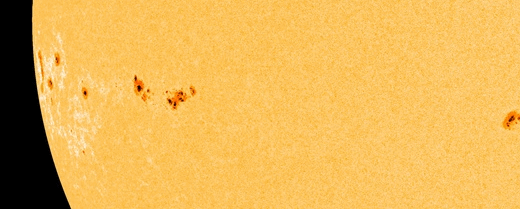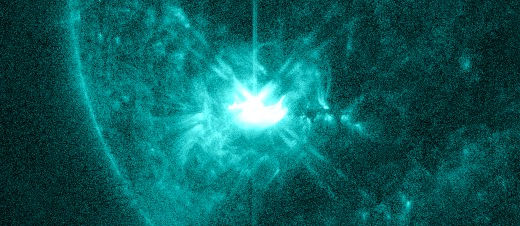https://www.youtube.com/watch?v=vsLzoR8qPPQ
BLIZZARD WARNING‼️ Strong Solar Flare / Earthquake WATCH‼️⚠️
6-hr max: X2 0906 UT Dec08
One person like that
https://www.youtube.com/watch?v=vsLzoR8qPPQ
BLIZZARD WARNING‼️ Strong Solar Flare / Earthquake WATCH‼️⚠️

COMPLEX SUNSPOTS ARE TURNING TOWARD EARTH: NOAA forecasters estimate a 35% chance of an X-class solar flare today. If so, it will probably come from one of these sunspots now turning toward Earth:
Numbered AR3883 and AR3886, the two active regions are unusually complex. The trailing group (3886) looks more like a shotgun blast than an ordinary sunspot, with more than 10 scattered dark cores. Mixed-polarity magnetic fields arcing between those cores could easily reconnect and explode.
#X-ray #Solar #Flares
6-hr max: M5 0850 UT Nov06
24-hr: M5 0850 UT Nov06

THE #SKY EXPLODED': A CME gently grazed Earth's magnetic field on Oct. 26th. At first it seemed like nothing would happen. Then, "the sky exploded," says Terence Murtagh, who took this picture using his iPhone 16 outside Tromso in #Norway:
"In many decades of viewing and photographing #auroras, I've never seen so many spectacular bright multicoloured coronas bursting over the sky," he says. "I couldn't believe my eyes as a small group of us were transfixed by this cosmic kaleidoscope. It was probably caused by the tail of the weak CME.
#X-ray #Solar #Flares
6-hr max: C8 0324 UT Oct27
24-hr: M8 0820 UT Oct26
#X-ray #Solar #Flares
6-hr max: X1 1547 UT Oct09
24-hr: X1 0156 UT Oct09
https://youtube.com/watch?v=NHWKW4x3U80

#X-CLASS SOLAR #FLARE: #Sunspot AR3848 was directly facing #Earth this morning, Oct. 8th (0156 UTC), when it unleashed a powerful X1.8-class solar flare. NASA's Solar Dynamics Observatory recorded the extreme #ultraviolet #flash:
This explosions lasted more than 4 hours, so long that it lifted a massive CME out of the #sun's atmosphere. Take a look at these preliminary coronagraph images from NASA's STEREO-A spacecraft. This #CME will certainly hit Earth later this week, potentially sparking a new round of geomagnetic storms.
#X-ray #Solar #Flares
6-hr max: C8 0730 UT Oct09
24-hr: X1 0156 UT Oct09
explanation | more data
Updated: Today at: 1255 UT

#CME COULD HIT #EARTH AND #COMET T-ATLAS: SOHO coronagraphs are obtaining some remarkable images today. One of the brightest comets in decades, Comet Tsuchinshan-ATLAS (C/2023 A3), is passing through the field of view while the sun emits a series of bright CMEs. The first CME in this movie appears to be on course to hit both Earth and the comet:
Hurled into space by a powerful X2-class solar flare on Oct. 7th, the CME could strike the comet later today or perhaps early on Oct. 9th, The impact could actually rip off the comet's tail. The same thing happened to Comet Enke in April 2007. A broken tail is something astronomers should look for when Comet Tsuchinshan-ATLAS emerges from the sun's glare later this week.
According to a NASA model, the CME will graze Earth late on Oct. 9th or early on Oct. 10th. The impact could cause a another geomagnetic storm with auroras at mid-latitudes in the USA and Europe. NOAA analysts are looking at this CME now and may soon issue a refined forecast
#X-ray #Solar #Flares
6-hr max: C5 1750 UT Oct08
24-hr: X2 1913 UT Oct07
CHANCE OF MORE X-FLARES TODAY: The solar disk is filled with big sunspots. Three of them (3842, 3843, 3848) have unstable 'delta-class' magnetic fields that harbor energy for strong solar flares. NOAA forecasters estimate a 75% chence of M-class flares and a 35% chance of X-flares during the next 24 hours.
#X-ray #Solar #Flares
6-hr max: M1 0825 UT Oct05
24-hr: M1 0825 UT Oct05
explanation | more data
Updated: Today at: 1200 UT
HE STRONGEST #FLARE YET: Sunspot AR3842 exploded again today, producing the strongest #solarflare of Solar Cycle 25 so far. NASA's Solar Dynamics Observatory recorded the #X9.1-category blast:

#Radiation from the flare ionized the top of #Earth's atmosphere and caused a deep shortwave blackout over Africa and the South Atlantic. Ham radio operators in the area may have noticed loss of signal at frequencies below 30 MHz for as much as a half an hour after 12:18 UTC.
Of greater interest is the #CME. Preliminary SOHO coronagraph images show a halo CME emerging from the blast site. This CME will probably strike Earth on Oct. 6th, adding its effect to that of an earlier CME expected to arrive on Oct. 4th. #Auroras are therefore likely this weekend.
#X-ray #SolarFlares
6-hr max: #X8 1218 UT Oct03
24-hr: X8 1218 UT Oct03
#Om namah shivaya

A preliminary NASA model predicts it will hit #Earth on Oct. 5th.
#X-ray #SolarFlares
6-hr max: M3 0538 UT Oct02
24-hr: X6 2220 UT Oct01

Göran Strand photographed a rainbow-outburst of #auroras over Östersund, #Sweden:
#X-ray #SolarFlares
6-hr max: M1 1756 UT Sep13
24-hr: M5 0656 UT Sep13
#X-ray #SolarFlares
6-hr max: M6 1443 UT Sep12
24-hr: X1 0943 UT Sep12
NEW #SUNSPOT EMITS #X-FLARE: Earth-orbiting satellites detected a strong X1.3-class solar flare today (Sept. 12th @ 0943 UTC). It came from a new and apparently large sunspot emerging over the sun's southeastern limb. The sunspot is not facing Earth now, but it will be early next week,
The number of #sunspots has been increasing at an exponential rate for the past couple of months.


BIG ONE IS HEADING FOR VENUS: Yesterday, Sept. 1st, something exploded behind the sun's southeastern limb. The source of the blast was not visible, but it hurled a magnificent CME into space:
The #CME won't hit #Earth. Instead, it is heading for #Venus.
#X-ray #SolarFlares
6-hr max: M2 1343 UT Sep02
24-hr: M2 1343 UT Sep02


ANTI-TAIL OF #COMET 12P: Comet tails are supposed to point away from the sun. Comet 12P/Pons-Brooks just sprung a tail in the opposite direction--an anti-tail. It's the narrow spike pointing toward the sun in this picture taken June 1st by amateur astronomers Michael Jäger, Gerald Rhemann and Lukas Demetz:
Anti-tails are an optical illusion. They appear when Earth passes through a comet's orbital plane, which, for Comet 12P, is happening this week. During the crossing, the sharp edge of the comet's fan-shaped dust tail appears to point toward the sun.
"Earth crosses the comet's orbital plane on June 6th, so we will see this 'neck-line' structure for several more days," says Jäger.
Comet 12P (magn. +7) is not visible to the naked eye, but it is an easy target for amateur telescopes. Southern hemisphere astronomers can find the comet in the constellation Lepus about 20 degrees below the celestial equator. The antitail will narrow in the days ahead, reaching maximum sharpness on June 6th.
#X-ray #SolarFlares
6-hr max: M2 0631 UT Jun04
#X-ray #SolarFlares
6-hr max: X1 1836 UT Jun01

NOAA forecasters remain confident that a CME will graze Earth's magnetic field on June 1st. It was hurled into space by an X1.4-flare on May 29th. The glancing blow could cause G2-class geomagnetic storms.
https://spaceweather.com/